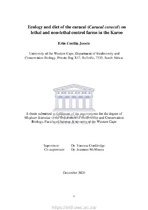| dc.description.abstract | Human-wildlife conflict is an ongoing issue worldwide. Within South Africa, human-carnivore conflict (HCC) as a result of carnivore depredation on small-livestock causes large-scale losses, and promotes the use of predator management tools by farmers. Despite being one of the major offenders involved in HCC, caracals, and their ecology in particular, are understudied. This is mainly due to high levels of persecution, coupled with their elusive nature. Within the Karoo region of South Africa, pastoralists make use of large-scale lethal predator controls in an attempt to remove the offenders, or non-lethal predator controls to protect livestock and deter predators. However, the effects of these various predator control techniques on caracal ecology have not been widely tested. Therefore, the aims of this thesis were, firstly, to assess caracal diet on lethal and non-lethal treatment farms in the Karoo; secondly, to investigate the drivers of caracal habitat selection on a non-lethal farm in the Karoo; and finally, to evaluate caracal activity patterns on the non-lethal farm. To do this, I made use of two non-invasive techniques (i.e. scat analysis and camera trapping). Caracals appeared to favour natural prey across all sites, with livestock remains only found in scats collected at the lethal treatment farm. Caracals had the broadest dietary breadth on the non-lethal treatment site, and the narrowest on the lethal treatment site. The main components of caracal diet included small mammals, lagomorphs, rock hyraxes (Procavia capensis), wild ungulates and arthropods. Caracal habitat selection was explained by resource dispersion and environmental features Interestingly, the presence of livestock was not a major consideration in caracal habitat selection. Caracals were mainly nocturnal but became increasingly crepuscular during winter. In addition, caracal activity overlapped significantly with black-backed jackals (Canis mesomelas), lagomorphs and common duikers (Sylvicapra grimmia). Caracals showed plasticity in their activity patterns based on seasonal temperature fluctuations, and partially human avoidance. This study contributes to understanding how caracal ecology differs on differently managed livestock farms. Throughout this study, the importance of both a natural prey base, as well as natural lands to caracal survival have been revealed. These findings can contribute to caracal conservation in HCC areas. | en_US |

